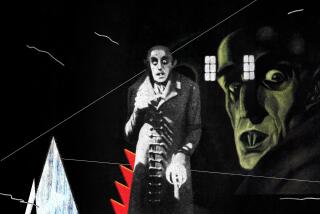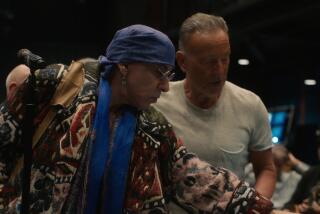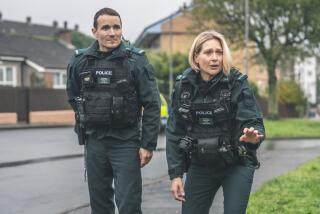In ‘Blinded By the Light,’ racism, Thatcher-ism and economic struggle influence ’80s nostalgia
LONDON — The 1980s don’t have their usual glossy sheen in Gurinder Chadha’s “Blinded By the Light.” Set in 1987 and based on Sarfraz Manzoor’s memoir “Greetings from Bury Park: Race, Religion and Rock ’N’ Roll,” the story follows a young Pakistani British man named Javed (who is closely based on Manzoor) as he discovers the music of Bruce Springsteen, whose lyrics reflect the working-class struggle of Javed’s own family.
To re-imagine the era, Chadha, who also co-wrote and produced the film, wanted to capture a graphic visual aesthetic, with blocks of bright color and strong lines, bringing in the grittiness that defined a time when most of Britain was out of work and a collective depression gripped the country.
From the composition of the shots to the production design, the film emphasizes imagery that can seem purposefully stark compared to the usual look of ’80s movies.
“The ’80s were far from shiny,” Chadha says. “They were gritty. We didn’t want to glamorize it. We shot it almost like it was one of those Russian Constructivist films.”
The reality of 1987 Britain, in fact, stood in juxtaposition to the glossy pop music of the era, particularly in the areas outside London. The town of Luton, where “Blinded By the Light” is set, can be found just north of London. It was there, in the suburb of Bury Park, that Manzoor grew up.
Today’s Luton isn’t all that different, with much of the run-down architecture — the results of several attempted revitalizations — still in place. Production designer Nick Ellis used the existing Luton town center and The Mall, then known as the Arndale Centre, in creating the sets. His team built a Job Centre, a government-funded employment agency, in an empty shop front, and used a school in Hillingdon as Luton College, where Javed, played by Viveik Kalra, goes to school.
“Blinded by the Light,” directed by Gurinder Chadha, uses the life-changing anthems of Bruce Springsteen in the manner of India’s popular Bollywood musicals.
“It would have been quite easy to do that high gloss version of the ’80s — all the digitization and computer games and mobile phones,” Ellis says. “But there was a massive section of our population — and Luton was part of it — who couldn’t afford it. There was such uncertainty with jobs and money and income. That’s how most of us outside of London lived. This was about representing how people lived. In that time, people didn’t own their televisions and video cassette recorders — you went down to the high street and you paid a monthly rent for them — all that was taken into consideration.”
For Javed’s family home, Ellis found an estate of council houses in Pinner. The real neighborhood was used for exteriors, while the house’s rooms, including Javed’s bedroom, were built on a soundstage. Javed’s bedroom was key to revealing the character’s evolution as he discovers Springsteen, and Ellis was able to secure the rights to several original Springsteen posters from the time. The graphics team reprinted the posters, which Javed scores for free from a record store.
That sort of authenticity extends everywhere, especially to the cars, which Ellis sourced from a collector. In 1987, people in Luton wouldn’t have been driving new vehicles — or even cars that were a few years old. Ellis found the same canary yellow Vauxhall Manzoor’s dad was driving from a second-hand dealer and replaced the engine, and populated the streets in every scene with the old, run-down cars people would have owned during a time of economic downturn.
The tech gear, including stereos and record players, was also original. Even Javed’s Sony Walkman, which he carries with him constantly, dates back to ’87 (and is now so vintage that 19-year-old Kalra didn’t know how to insert a cassette).
The costumes too actually date back to the ’80s. Costume designer Annie Hardinge scoured vintage shops around London for original pieces. Anything she couldn’t buy, she rented and then replicated.

Throughout the film, iconic looks of the era are evident, with Hardinge taking inspiration from such teen movies as “The Breakfast Club.” That comes into play most in the college, where the hundreds of students’ bright costumes reflect distinct groups — and even real-world musicians. If you look closely, there’s a trio of girls dressed as Bananarama and a Boy George-inspired kid walking the halls.
“There was all sorts going on in the background that maybe you’ll pick up on if you watch it a second time,” Hardinge says. “We did try to bring musical icons into the background, sort of how school kids copy their idols.”
“Gurinder’s intent was really to pay homage to all the different groups,” adds makeup and hair designer Jojo Williams. “We wanted to capture the time and the music. We were recreating the various music genres, almost like little bands. That was really fun.”
For Javed’s look, the idea was to keep it classic. As he gets more and more into Springsteen, Javed begins to model himself on the Boss, wearing ripped plaid shirts and lots of denim, as well as a red bandana tied around his neck.
“When you’re given this artist’s work you have to be very careful because you don’t want to exploit Bruce for his generosity,” Chadha says. “So I used little bits. Javed had Bruce-inspired looks, but we didn’t necessarily have to have Bruce, Bruce, Bruce everywhere.”
While Springsteen’s songs are the focal point of the film — as well as the film’s soundtrack — the sound of 1987 Britain threads through the story. Music co-supervisors, Pete Saville and Zoë Ellen Bryant, brought in scripted tracks such as The Pet Shop Boys’ “It’s a Sin” and notable songs of the year, including Level 47’s “Lessons In Love” and A-ha’s “The Sun Always Shines on TV.” The synth, shimmery vibe contrasts with Springsteen’s homegrown rock.
“The music was quite escapist,” Saville says. “It was this shiny world you could enter into when politically the times were pretty awful. In the U.K. you had so much turbulence. It was about getting away from the reality of relentless Thatcher-ism and the struggle of the working class and the onslaught of rabid capitalism.”
The shadow of late prime minster Margaret Thatcher looms large over the story, particularly as the economic troubles of the working class become more apparent. Re-creating 1987 wasn’t just about cassettes and denim jackets: Chadha had to showcase the intense political tension and racist undercurrents of the time.
The director herself spray-painted the swastika graffiti that appears in Javed’s neighborhood, stepping in when a member of the art department felt he couldn’t do it. Ellis cleared the rights to use a billboard of Thatcher from 1987, which showcased a slogan urging unity in Britain. It appears in a scene depicting a National Front march, in which the former right-wing political party protests against immigrants and non-whites in the U.K. The march — and the counter-protest alongside it — is based on several real marches from the year.
“On the first take, the whole film crew was just stunned into silence,” Chadha remembers. “It looked so real, and it was such a reminder of the anger and the hate that those marches were about. We were all like, ‘Oh my, God, what are we doing? This is horrible.’ But we’re re-creating this as a warning to show how awful it was. I needed to show that reality.”
In some ways, much has changed since 1987. But as newly minted prime minster Boris Johnson again calls for unity in a Britain tinged with racism, there are moments in “Blinded By the Light” that still resonate today. Chadha began working on the script in earnest only days after Brexit, and her feelings about that event linger.
“I channeled all my anger and frustration and fear over Brexit into this script,” the director says. “So even though it’s ’87, I made all that racism stuff and the rise of the right very visceral as a warning to what it was like then. And to make you feel like what it means if you’re going to be a racist and how it affects ordinary people. I made it my anti-Brexit movie. Since then, things have just gotten more and more resonant.”
Still, “Blinded By the Light” is ultimately about hope, much like the music of the time. It may be set in a Luton of the past, but the film touches on something truly universal.
“Bruce stands for a particular kind of America — and always has done, from then to today,” Chadha says. “Those songs are from the ’70s and ’80s, but he’s No. 1 with an album right now all over the world, which is saying the same kinds of things. He’s sharing the same sentiments: Life’s a struggle, and you’ve got to find your promised land within it. I think people respond to Bruce’s version of America, which is where people care about each other.”
More to Read
Only good movies
Get the Indie Focus newsletter, Mark Olsen's weekly guide to the world of cinema.
You may occasionally receive promotional content from the Los Angeles Times.










